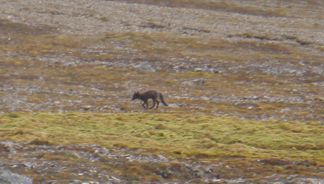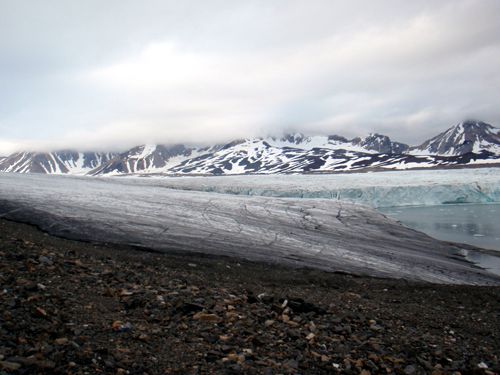Today, we have done most of our work and we even took a short break. For two hours, we went for a walk at the foot of the 500-metre high mountain overlooking the base. The main purpose was still scientific, looking at Hans Glacier from above and checking the latest signs of calving. There are two autonomous recorders on the bottom at the end of the fjord now: one is still recording noises from the glacier and the icebergs (and the hydrographic vessel, still anchored not far).
On the way, we see flocks of little auks returning from the sea. They are extremely noisy, and it seems there are thousands of birds all shouting at once (there probably are). The ornithologists tell me they nest in the rocks (no twigs here, of course, to build up nests). The auks try to find comfortable holes in the ground, frozen most of the year, and sometimes use burrows 1.5 m long deep. This removes most of the surrounding cold and also the threat of predators.
Talking of predators, we were cautiously avoiding groups of reindeers, napping on the soft, green moss, when a dark speck suddenly reared its head on our path. It was an Arctic fox, who looked at us with increasing interest, then bolted out to go to the closest snow patch.

We saw fresh reindeer bones that he was gnawing on: no doubt scavenged from further away. The fox comes back as soon as we are at a safe distance, and carries on eating ...
After more walking and climbing on small rocks and different small moraines, we arrive just above the glacier. Still a lot of blue ice at its front, meaning the bottom ice is still being exposed and calves into the sea. There are many blue icebergs drifting away ... Up close, we can see the base of the glacier, and its sides, are eroded and form flanges. A small rivulet of icy water trickles on one side and into the sea ... It's beautiful, and also extremely informative: the base layer of glaciers is usually made of a slush of ice and water, lubricating it so that it can move forward. The surface of the glacier is criss-crossed by crevasses and similar features. Some of the Polar Station's crew regularly take measurements of the glacier's movements, using GPS and markers placed at key points on the ice. A risky business, but they seem very experienced (and very safety-conscious too: I talked with one of them yesterday, and most of his backpack was filled with safety-related equipment).

Respond